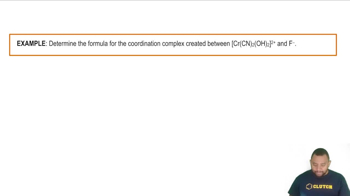Write the formula for each of the following compounds.
(a) Diamminesilver(I) nitrate
(b) Potassium diaquadioxalatocobaltate(III)

 Verified step by step guidance
Verified step by step guidance


Write the formula for each of the following compounds.
(a) Diamminesilver(I) nitrate
(b) Potassium diaquadioxalatocobaltate(III)
Write the formula for each of the following compounds.
(c) Hexacarbonylmolybdenum(0)
(d) Diamminebis(ethylenediamine)chromium(III) chloride
Which of the following complexes are chiral?
(a) Pt(en)Cl2
(b) cis-[Co(NH3)4Br2]+
(c) cis-[Cr(en)2(H2O)2]3+
(d) [Cr(C2O4)3]3-
Tris(2-aminoethyl)amine, abbreviated tren, is the tetradentate ligand N(CH2CH2NH2)3. Using to represent each of the three NCH2CH2NH2 segments of the ligand, sketch all possible isomers of the octahedral complex [Co(tren)BrCl]+.
Consider the octahedral complex [Co(en)(dien)Cl]2+, where dien = H2NCH2CH2NHCH2CH2NH2, which can be abbreivated
(a) The dien (diethylenetriamine) ligand is a tridentate ligand. Explain what is meant by 'tridentate' and why dien can act as a tridentate ligand.
(b) Draw all possible stereoisomers of [Co(en)(dien)Cl]2+ (dien is a flexible ligand). Which stereoisomers are chiral, and which are achiral?
The reaction of the octahedral complex Co(NH3)3(NO2)3 with HCl yields a complex [Co(NH3)3(H2O)Cl2]+ in which the two chloride ligands are trans to one another.
(a) Draw the two possible stereoisomers of the starting material [Co(NH3)3(NO2)3]. (All three NO2- ligands are bonded to Co through the N atom.)
(b) Assuming that the NH3 groups remain in place, which of the two starting isomers could give rise to the observed product?